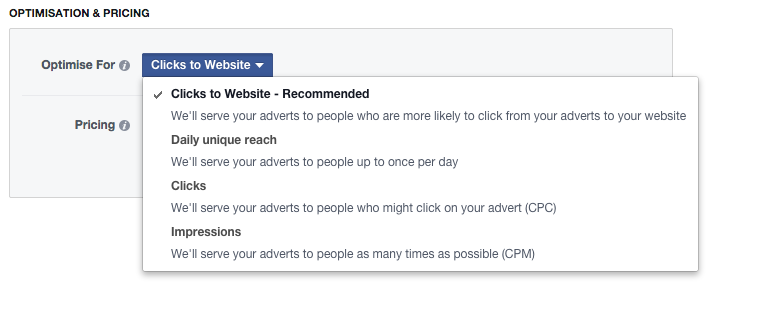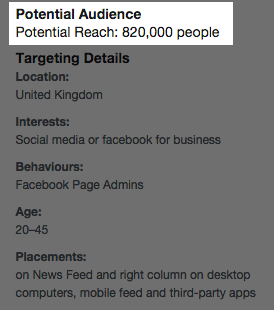Facebook Ads: Clicks to Website vs. Daily Unique Reach
Facebook Ads: Clicks to Website vs. Daily Unique Reach
Get weekly
HubSpot Updates
So you’re running an advert on Facebook to promote a recent blog you wrote, a new product or a new offer (or really anything at all that exists on your website) and you’re faced with the following options:

Ignoring the Clicks and Impressions options (as most people should be used to the differences between CPC and CPM by now), which of the first two should you choose?
Well, let’s start with a brief look at what each actually means…
Clicks to Website
(or the equivalent option for your advert goal)
By default this will be the option Facebook will select and the one it recommends (as you can see above). Choosing this will cause Facebook to ‘serve your adverts to people who are more likely to click from your adverts to your website’.
In other words, Facebook will now serve your advert to the people who are most likely to perform your desired action – in this case, clicking on your advert to take them to your website. This means that it is applying a whole new layer of targeting on top of the manual targeting you select when choosing your audience. Unfortunately, that’s about all the information you’ll get – Facebook doesn’t tell you how or what it uses to determine who to show the adverts to, it just does what it does.
Daily Unique Reach
Making its first appearance in the Power Editor in October last year (2014); Daily Unique Reach allows you to “serve your adverts to people up to once per day”. In other words, unlike above, Facebook no longer takes your desired action into account. Instead, it will simply show your advert to as many people within your target audience as possible with a maximum frequency of once per day and no more.
Which should you use?
Based on the two descriptions above you may well be thinking the answer to that question is “Clicks to Website – obviously”. Well, not necessarily.
The important thing to remember here is what ‘Clicks to Website’ is doing. Because Facebook is serving your advert to those that are most likely to carry out your desired action your target audience size is being refined and therefore going to be much smaller than the figure that Facebook generates as ‘Potential Audience’ (see below).

In the above example, we may well be OK as the audience size is large enough, but for smaller audiences such as your blog readers or newsletter subscribers (depending on the size of your brand) by selecting this option you may well be reducing your audience to a very niche group of people. This will make it difficult to spend larger budgets and particularly difficult to do so quickly.
What’s also important to consider is the quality of your targeting. If you are using Interests targeting then it’s likely the people you are advertising to are not going to be particularly warm towards your brand, therefore optimising to those that are most likely to respond to your advert is a fairly solid plan. On the other hand, if you’re advertising to a group that already knows your brand and has some loyalty to it then is there really much of a need to optimise this further? Possibly, but probably not. If you’re running your adverts to audiences like your newsletter subscribers, blog readers or even those who Like your page, then they are going to be engaged already as it is. In this instance selecting Daily Unique Reach and trying to reach as many of them as possible is probably the better option.
To Summarise…
Clicks to Website (or equivalent option) – Use when you have very large audience sizes or an audience who is unlikely to be warm to your brand – e.g. audiences created through the standard Interest targeting options.
Daily Unique Reach – Use when you already have very targeted audiences and are confident in their quality or when the audience size is small – e.g. your existing customer base.
A Caveat
Of course, there are always exceptions to the rules, for example if you were running an advert to sign up to a new service or purchase a new product and you were serving it to your considerable, existing customer base then you might want to optimise it in order to create a new Custom Audience of ‘Dependable Purchasers’ within your customer base (or something similar).
Our content includes affiliate links. This means that we may receive a commission if you make a purchase through one of the links on our website. This will be at no cost to you and helps to fund the content creation work on our website.